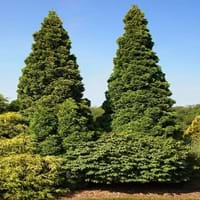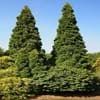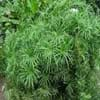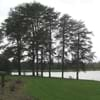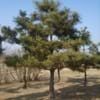Life Span
Perennial
Perennial
Type
Needled or Scaled Evergreen
Flowering Plants, Fruits, Herbs
Origin
Northeastern United States, Mid-Atlantic United States, Southeastern United States, North-Central United States, Central United States, Canada
Australia, Tropical Indomalaya
Types
Not Available
Cavendish Bananas, Lady Finger Bananas, Pisang Raja, Williams Bananas, Cooking Bananas
Number of Varieties
Not Available
Habitat
Dry areas, Lake Sides, riparian zones, Slopes, Upland
Subtropical climates, Tropical rainforest, Tropical regions
USDA Hardiness Zone
3-7
8-15
Sunset Zone
A2, A3, H1, H2, 1a, 1b, 2a, 2b, 3a, 3b, 4, 5, 6, 7, 8, 9, 15, 16, 17, 21, 22, 23, 24
H1, H2, 2a, 2b, 3a, 3b, 4, 5, 6, 7, 8, 9, 14, 15, 16, 17, 18, 19, 20, 21, 22, 23, 24
Habit
Pyramidal
Upright/Erect
Flower Color
Yellow, Yellow Brown
Burgandy, Ivory, Purple, White, Yellow
Flower Color Modifier
Bicolor
Not Available
Fruit Color
Brownish Red, Red
Red, Yellow, Yellow Brown, Yellow green
Leaf Color in Spring
Green, Dark Green
Dark Green
Leaf Color in Summer
Green, Dark Green
Green
Leaf Color in Fall
Green, Dark Green
Green
Leaf Color in Winter
Green, Dark Green, Brown
Green
Leaf Shape
Scale-like imbricate
Cone shaped
Plant Season
Spring, Summer, Fall, Winter
Fall, Spring, Summer
Sunlight
Full Sun, Partial Sun
Full Sun, Partial shade
Type of Soil
Loam, Sand
Clay, Loamy
The pH of Soil
Acidic, Neutral
Neutral, Slightly Acidic
Soil Drainage
Average
Well drained
Bloom Time
Spring
Early Fall, Early Summer, Late Spring, Late Summer, Summer
Tolerances
Drought
Not Available
Where to Plant?
Ground
Ground
How to Plant?
Seedlings, Stem Cutting
From bulbs
Plant Maintenance
Medium
Medium
Watering Requirements
Drought Tolerant, Keep the ground moist but not water-logged, Requires regular watering
Allow soil to be completely dry in between waterings, It cannot sustain wet-feet, Requires regular watering, Water every two or three days during warmer months
In Summer
Lots of watering
Lots of watering
In Spring
Moderate
Moderate
In Winter
Average Water
Average Water
Soil pH
Acidic, Neutral
Neutral, Slightly Acidic
Soil Type
Loam, Sand
Clay, Loamy
Soil Drainage Capacity
Average
Well drained
Sun Exposure
Full Sun, Partial Sun
Full Sun, Partial shade
Pruning
Remove damaged leaves, Remove dead branches, Remove dead leaves
Prune after harvesting, Remove dead or diseased plant parts
Fertilizers
All-Purpose Liquid Fertilizer
All-Purpose Liquid Fertilizer
Pests and Diseases
Citrus leaf miner, Drought, Edema, Gray mold
Anthracnose, Banana aphid, Banana mosaic, Black sigatoka, Bunchy top, Cigar end rot, Coconut scale, Moko disease, Panama disease, Rhizome rot, Yellow sigatoka
Plant Tolerance
Drought
Drought
Flower Petal Number
Single
Single
Fragrant Bark/Stem
Yes
No
Foliage Texture
Medium
Bold
Foliage Sheen
Glossy
Glossy
Attracts
Birds
Not Available
Allergy
Anaphylaxis, Hives, Itchy eyes, Red eyes, Runny nose, Skin rash, sneezing, Watery eyes
Anaphylaxis, Mouth itching, Throat itching
Aesthetic Uses
Showy Purposes
Not Used For Aesthetic Purpose
Beauty Benefits
Not Available
Not Available
Environmental Uses
Air purification
Air purification
Medicinal Uses
anti rheumatic, Astringent, Diuretic, Expectorant, Tonic
Anemia, Antioxidants, Bronchitis, Diarrhea, Hangover, Heartburn, High blood pressure, Kidney problems, Menstrual Disorders
Part of Plant Used
Bark, extracted oil, Leaves, Twigs
Flowers, Fruits
Other Uses
Medicinal oil, Used as firewood, Used in herbal medicines, Used in Homeopathy
Pulp can be used to make rope place mats and other goods, Used As Food, Used in paper industry
Used As Indoor Plant
No
No
Used As Outdoor Plant
Yes
Yes
Garden Design
Feature Plant, Foundation, Hedges, Mixed Border, Screening, Wind Break
Showy Tree
Botanical Name
THUJA occidentalis
Banana Tree
Common Name
northern white cedar, swamp cedar, false white ceda
Banana Tree
In Hindi
Thuja occidentalis
केले के पेड़
In German
Abendländischer Lebensbaum
Bananenbaum
In French
Thuya occidental
Bananier
In Spanish
Tuya del Canadá
Banano
In Greek
Thuja occidentalis
μπανανιά
In Portuguese
Thuja occidentalis
árvore de banana
In Polish
Żywotnik_zachodni
Banana drzewa
In Latin
Thuja occidentalis
Musa sapientum fixa ligno
Phylum
Tracheophyta
Magnoliophyta
Class
Pinopsida
Liliopsida
Order
Pinales
Zingiberales
Family
Cupressaceae
Banana
Clade
Not Available
Monocotyledonous
Tribe
Not Available
Not Available
Subfamily
Not Available
Not Available
Properties of White Cedar and Banana Tree
Wondering what are the properties of White Cedar and Banana Tree? We provide you with everything About White Cedar and Banana Tree. White Cedar doesn't have thorns and Banana Tree doesn't have thorns. Also White Cedar does not have fragrant flowers. White Cedar has allergic reactions like Anaphylaxis, Hives, Itchy eyes, Red eyes, Runny nose, Skin rash, sneezing and Watery eyes and Banana Tree has allergic reactions like Anaphylaxis, Hives, Itchy eyes, Red eyes, Runny nose, Skin rash, sneezing and Watery eyes. Compare all the properties and characteristics of these two plants. Find out which of these plant can be used as indoor plant. If you are interested to decorate your house and garden, find out aesthetic uses, compare them and select the plant which will beautify your surrounding. Along with beautification, try comparing medicinal and edible uses of White Cedar and Banana Tree and you can choose the plant having best and most benefits.
Season and Care of White Cedar and Banana Tree
Season and care of White Cedar and Banana Tree is important to know. While considering everything about White Cedar and Banana Tree Care, growing season is an essential factor. White Cedar season is Spring, Summer, Fall and Winter and Banana Tree season is Spring, Summer, Fall and Winter. The type of soil for White Cedar is Loam, Sand and for Banana Tree is Clay, Loamy while the PH of soil for White Cedar is Acidic, Neutral and for Banana Tree is Neutral, Slightly Acidic.
White Cedar and Banana Tree Physical Information
White Cedar and Banana Tree physical information is very important for comparison. White Cedar height is 90.00 cm and width 90.00 cm whereas Banana Tree height is 16.08 cm and width 7.87 cm. The color specification of White Cedar and Banana Tree are as follows:
White Cedar flower color: Yellow and Yellow Brown
White Cedar leaf color: Green and Dark Green
Banana Tree flower color: Burgandy, Ivory, Purple, White and Yellow
- Banana Tree leaf color: Dark Green
Care of White Cedar and Banana Tree
Care of White Cedar and Banana Tree include pruning, fertilizers, watering etc. White Cedar pruning is done Remove damaged leaves, Remove dead branches and Remove dead leaves and Banana Tree pruning is done Prune after harvesting and Remove dead or diseased plant parts. In summer White Cedar needs Lots of watering and in winter, it needs Average Water. Whereas, in summer Banana Tree needs Lots of watering and in winter, it needs Average Water.
